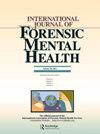What Happens after Discharge from a Forensic Psychiatric Hospital?: An Analysis of Causally Complex Patterns of Recovery among People Found Non-criminally Responsible on Account of Mental Disorder
IF 0.9
4区 医学
Q3 CRIMINOLOGY & PENOLOGY
International Journal of Forensic Mental Health
Pub Date : 2022-10-07
DOI:10.1080/14999013.2022.2128111
引用次数: 0
Abstract
Abstract In this article, we explore which configurations of risk and protective factors explain recovery in a sample of 60 forensic psychiatric patients 6 months after they have been discharged from a psychiatric institution. In line with the recovery-oriented paradigm that emerged in psychiatry, we focus on the role dynamic risk factors and dynamic protective factors play in recovery. Using fuzzy set qualitative comparative analysis, we explore which configurations of conditions explain recovery in conjunction with each other. This entails that the configurations of conditions are codependent sets of conditions, in the sense that the conditions in the configuration explain recovery only in the presence of the other conditions in the configuration, with important implications for research and practice. Our results suggest that the absence of dynamic risk factors is a necessary condition for recovery, and that both the absence of dynamic risk factors and the presence of dynamic protective factors play a pivotal role in recovery, often in combination with other factors, such as absence of symptoms, absence of historical risk factors, and absence of alcohol dependence. We conclude by stressing the important role dynamic risk and protective factors play in recovery, and underline their co-dependence on other factors.从法医精神病院出院后会发生什么?精神障碍非刑事责任人康复的复杂因果模式分析
摘要在这篇文章中,我们在60名法医精神病患者的样本中探讨了哪些风险和保护因素可以解释康复 他们从精神病院出院几个月后。根据精神病学中出现的以康复为导向的范式,我们关注动态风险因素和动态保护因素在康复中的作用。使用模糊集定性比较分析,我们探讨了哪些条件配置可以相互解释采收率。这意味着条件的配置是相互依赖的条件集,因为配置中的条件只能在配置中存在其他条件的情况下解释恢复,这对研究和实践具有重要意义。我们的研究结果表明,缺乏动态风险因素是康复的必要条件,缺乏动态危险因素和存在动态保护因素在康复中都发挥着关键作用,通常与其他因素相结合,如没有症状、没有历史风险因素和没有酒精依赖。最后,我们强调了动态风险和保护因素在复苏中发挥的重要作用,并强调了它们对其他因素的共同依赖性。
本文章由计算机程序翻译,如有差异,请以英文原文为准。
求助全文
约1分钟内获得全文
求助全文

 求助内容:
求助内容: 应助结果提醒方式:
应助结果提醒方式:


